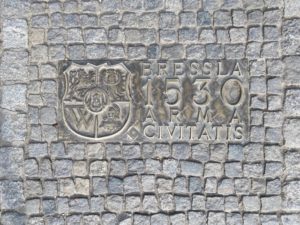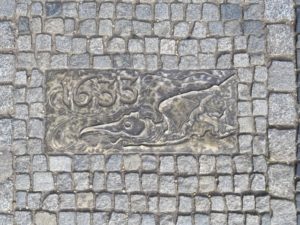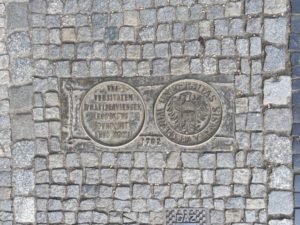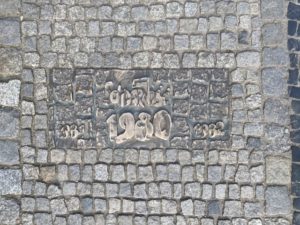The most important Events in the History of Wroclaw
Updated: 01/02/2024
/
The History of Wroclaw has many unique elements. It is full of different rulers who shaped the city and left their own marks, many cultures who lived and loved the city for ages, but also dramatic events that impacted millions of lives.
We do not want to write a book about the history as there are much smarter people to do so… But as we love the city, we want to provide a little 5-10 minutes overview of the events in Wroclaw. With that knowledge, it will be much easier to understand the present.
Let’s have a little walk first
There are multiple ways to learn more about the history of Wroclaw. One is the history trail in the city which we will bring to your homes here.
But well, it looks that sometimes history can be subject to interpretation… That is why we saw a reason to create some cool infographics of Wroclaw’s History as well. This will be the second part of this article where you can find all events together.
Of course at last after that, we are going to point out some cool museums where you can spend hours to learn more…
The Walk of History in Wroclaw
One way to see the 20 most important events of the city actually is to take the little history trail which is located in the street plac Nankiera in the city centre. We will bring this history trail home to you now and walk through it together!
Every important event got its own special stone in the pavement and we really like that idea. However, one thing is a bit “questionable” to be honest, but we will explain that later. Let us start our walk…
The most important Events in Wroclaw’s History
Establishment of the bishopric in Wroclaw
The Bishopric of Wroclaw was founded by Otto III and Bolesław I the Brave under the first name of the city: Vratislavia. This is the first written mention of Wroclaw.
Mongol invasion of the city
During the Mongol invasion in 1241, the city was destroyed significantly.
Wroclaw receives municipal rights
With the Magdeburg city rights, the market squares of Wroclaw were delineated.
The loss of Silesia to the Kingdom of Bohemia
After Henry VI died, the city falls to the Bohemian crown.
Wroclaw in the Habsburg Monarchy
Following the events of the Mohacz Battle and the death of Louis Jagiellończyk, the city becomes part of the Habsburg Monarchy.
Establishment of the current coat of arms
Ferdinand I Habsburg granted the coat of arms to the city – which is again in use today. You find a more colourful version of it in our infographic at the bottom.
The bubonic plague in Wroclaw
Over 18.000 people died in the bubonic plague, at that time a quite significant amount of the population, almost half of it.
Establishment of the University of Wroclaw
With financial resources from Leopold I, the University of Wroclaw was founded as Jesuit University. If you check the door of it, you see the two letters LI for Leopold I but intentionally it also looks like “U” for University.
Prussian reign
After the Silesian war between Austria and Prussia, the new rulers of the city are……. The Prussians!
The tailors’ revolution
Journeymen were fighting against repressions in 1793, however the army was able to stop it.
Napoleonic troops seize Wroclaw
Napoleons troops arrived in 1806 to Wroclaw and the city capitulated in 1807. This meant the end of fortification for Wroclaw.
The first railway line on *todays* Polish territory
Well, according to the sign on the history trail, in 1842 the first railway started from Polish territory. However, in that year we all know that unfortunately there was no Poland on the maps…. In our Infographics below, we just took the first railway in Wroclaw.
Construction of the Centennial Hall
Max Berg created his masterpiece – the Centennial Hall. Click here for more information on this wonderful building which is a UNESCO World Heritage Site since 2006.
Festung Breslau
Actually already on 25 July 1944, Wroclaw is declared to be a fortress that cannot be given up at any cost. Within less than one year, the city capitulated. Again, here some quite significant events are missing, we have added them to our infographic at the bottom.
Solidarity
The Solidarity movement emerged from increased dissatisfaction.
The Eucharistic Congress
Pope John Paul II. visited Wroclaw during the Eucharistic Congress, it was in May to June.
The great flood
One of the largest natural disasters in the history of Wroclaw – the great flood in July.
EURO 2012
Together with Ukraine, Poland hosted the EURO 2012.
European Capital of Culture
Together with San Sebastián in Spain, Wroclaw became the European Capital of Culture in 2016.
The World Games 2017
Disciplines like Karate, Sumo and Climbing belong to the World Games – which Wroclaw hosted in 2017.
Your Visit!
The most important event is still ahead – we hope it will be your visit in Wroclaw 🙂 If you plan a trip to Wroclaw, click here for our planning guides.
Infographics: History of Wroclaw
Of course, the history trail that we just walked together, a lot of important events are missing. Naturally there are lots of books about Wroclaw’s history and there can be many different levels of detail.
As the emperors of the city kept changing, we believe we found a better way than the history trail to provide you with an overview of what happened in the past. In our infographic you will not only find the most significant events of Wroclaw, but additionally it might be easier to see who ruled the city at which time.
A little hint: Click on the infographic to increase the size!
We hope that you liked our infographics about the history of Wroclaw!
The one above is too large for you and includes too many details? No worries, we have a compact version with all rulers of Wroclaw too. This will help you to determine who was in charge in which years. Of course by clicking on it, you can zoom in again.
You like them? Feel free to share them on social media! You may even use them for free on your own website if you like, please just make sure to link this article then 🙂
Interested in more History of Wroclaw?
We hope that our post already gave you a little bit of overview about Wroclaw’s history, but if you are still curious, we have some more recommendations for you!
Visit the Historical Museums
We have two favourite museums of Wroclaw when it comes to history and we can recommend the following:
- Centrum Historii Zajezdnia in particular for the 20th century in Wroclaw
- The City Museum of Wroclaw for the full 1000+ years of history
Some of the museums in Wroclaw even offer free entrance on one day per week – we created a little table for that in our article about the 15 best free things to do in Wroclaw.
Participate in a Historic Tour of Wroclaw
- Click here for the general city tour where you learn not only about history but also see the main sightseeing places
- Click here for the same as above but from a small electric car
- Click here for the dedicated Third Reich and World War 2 Tour
Read a book about Wroclaw and its history
We recommend the book “Uprooted” which provides a very detailed overview of the events when Wroclaw became a Polish city. Add it here to your wishlist:
In English: Here is the direct link to Amazon.de
In German: Here is the direct link to Amazon.de or if you prefer Buecher.de here.
The German version as eBook is currently much less expensive from Buecher.de here.
We hope that you enjoyed this post about the history of Wroclaw and its most important events!
You want to plan a trip to Wroclaw? Check out our planning guides here!
What we also recommend is our virtual free walking tour about German History in the alternative district Nadodrze – click here.
Do you have some comments on this article? Help us and also help other visitors by leaving your feedback in the comment section below!
You may also like

These Books about Wroclaw will get you through the Winter
10/02/2024
Best places to stay in Wroclaw: Hotel, Hostel, Camping and Apartments
17/10/2021






























